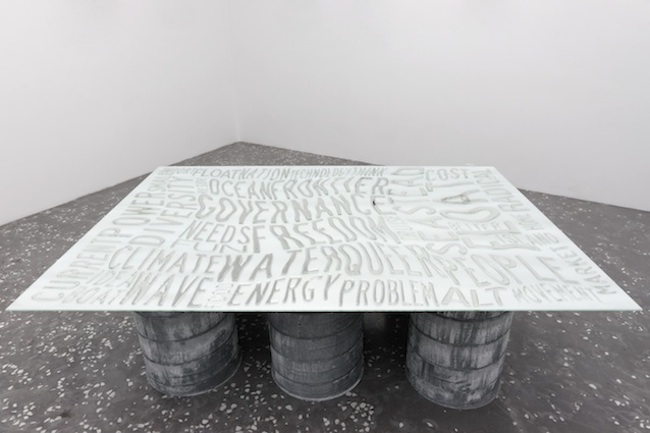
Daniel Keller. Zion + Platform (Seasteading Tag Cloud), 2013; mirrored glass, hydrophobic coating, distilled water, steel. Courtesy of Krauper-Tuskany Zeidler, Berlin, and New Galerie, Paris.
The term post-democracy has recently emerged in political theory and sociology as part of an effort to grasp the contemporary social order. The term is used by theorists such as Colin Crouch, Chantal Mouffe, and Jacque Rancière to describe a society where all the democratic institutions are in place—freedom of speech is respected, free elections are held, government officeholders are reelected or not—but where a small, moneyed elite is skewing the democratic playing field heavily in their favor. In a post-democracy, voters can choose between several political parties, but there is little or no difference between the representatives they elect: whether you go blue or red, you still end up with neoliberal policies.
In the last decade, the United States and Europe have seen a number of developments that suggest that post-democracy isn’t merely a potential trajectory for our societies but rather a social order we are already living in.
At the height of the euro crisis, for example, international creditors pressured the democratically elected government heads of Italy and Greece to resign, to be replaced with European Union–endorsed technocrats. The reason for this sidestepping of democracy: the bond yield spread was getting dangerously high, making government borrowing unsustainable.
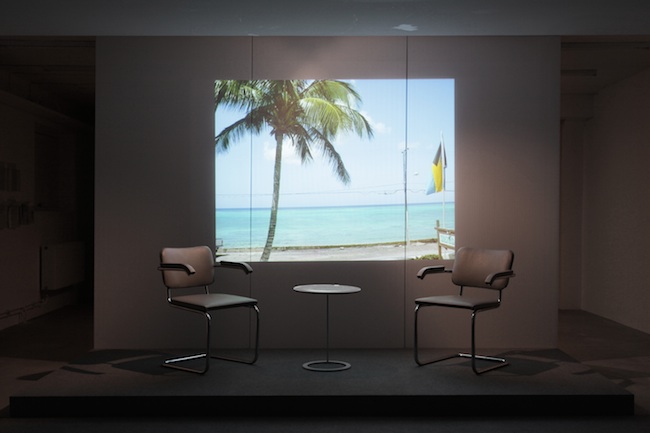
Goldin+Senneby, with Angus Cameron (economic geographer), K.D. (fiction writer), Kim Einarsson (curator/writer), Anna Heymowska (set designer), Marcus Lindeen (director), Eva Rexed (actor). Headless: From the Public Record, 2009 (installation view). Index, Stockholm.
When voters in France and Denmark turned their backs on austerity politics and elected left-wing parties in 2011 and 2012, they were promised increases in public spending and higher taxes on banks. Once the parties were in office, however, they rewarded the voters with more public austerity and lower corporate taxes. They explained their reneged campaign promises by claiming the reforms were necessary.
Faced with this reality, many voters lose trust in democracy. Globalization has made it more difficult for national governments to control their economies, and business elites use lobbying, outsourcing, and offshore tax havens as effective tools to sway policies. With no governments challenging the neoliberal status quo, democracies seem increasingly impotent compared to corporations, and political parties appear unable to form alternatives to the diktats of market forces.
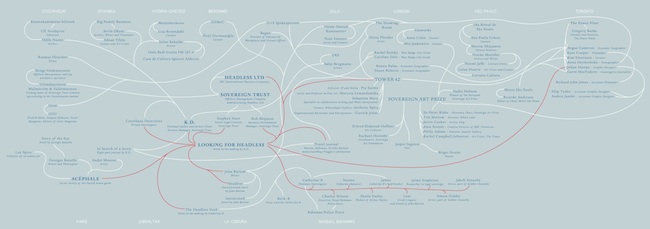
Goldin+Senneby, with Kim Einarsson (curator/writer) and Filip Tydén (graphic designer). Headless Mindmap, 2008.
In a post-democratic world, where politicians and central bankers keep telling us that no alternatives exist, one of the primary roles of the artist is to test and bend the rules of a seemingly orthodox system. In the past decade, artists such as Goldin+Senneby, Nuria Güell, and Daniel Keller have answered this challenge by using outsourced labor, tax havens, and offshore subsidiaries as central parts of their artistic practices. By appropriating corporate methods, language, and strategies, these artists explore the opacities of the system.
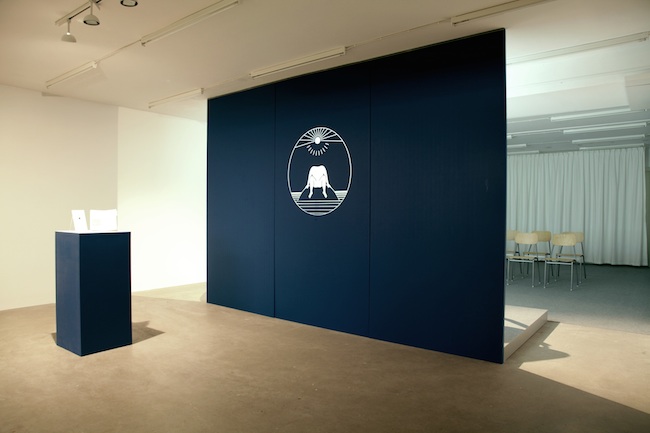
Goldin+Senneby, with Angus Cameron (economic geographer), K.D. (fiction writer), Kim Einarsson (curator/writer), Anna Heymowska (set designer), Marcus Lindeen (director), Eva Rexed (actor). Headless. From the Public Record, 2009 (installation view). Index, Stockholm.
In Goldin+Senneby’s Headless (2007–present), the artists approach the shady realm of offshore finance through an investigation of the real Bahamas-based company, Headless, Ltd. Imitating the corporate structures they critique, the artists have outsourced the production of Headless’s numerous texts, videos, and performances to various professionals. For example, a novelist was sent to the Bahamas to research the legal status of the company, a filmmaker was hired to produce a documentary, and another novelist wrote a docu-thriller about the ongoing investigation. What is real and what is not—and what role the artists play in all this—is not disclosed. Like an offshore company, Headless is evasive and concealed. While corporations use offshore subsidiaries to circumvent taxes and regulations, Goldin+Senneby use Headless to continually displace their artistic position.

Daniel Keller. Absolute Vitality Inc. Offshore Subsidiary (Sea But Volatility LLC, Nevis), 2013; International Business Corporation (IBM) documents, NRS hydrolock bag. Courtesy of Krauper-Tuskany Zeidler, Berlin, and New Galerie, Paris.
In his show Lazy Ocean Drift, the American artist Daniel Keller (formerly of AIDS-3D) has worked with a constellation of ideas about offshore finance and the concept of seasteading, the creation of floating, semipermanent cities in international waters. Presented by libertarians as a way of fuelling innovation and experimenting with new forms of government, seasteads and other offshore havens have received serious attention from business elites. Using sound, installation, and video, Keller addresses these entirely artificial constructions through dreamy, exotic imagery, encapsulating what is essentially a fantastic escape plan for the economic elite.
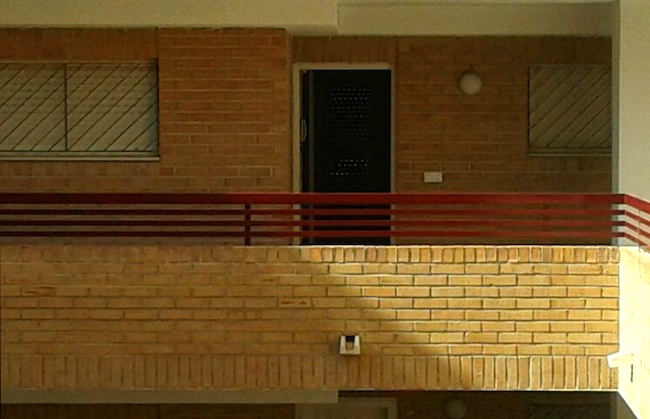
Núria Güell. Intervencion #1, 2012 (detail: flat acquired by the bank after the door was taken away). Courtesy of the artist.
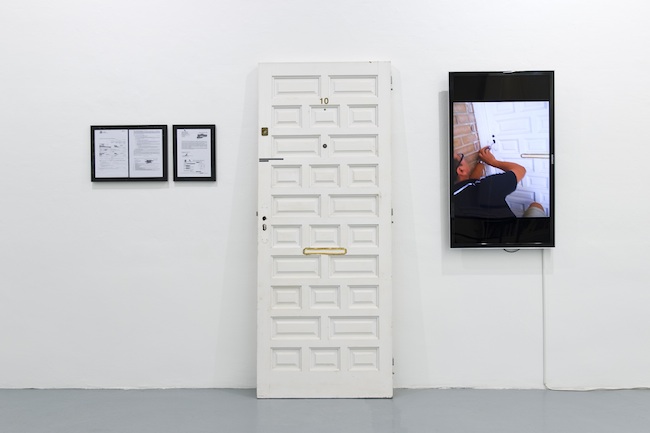
Núria Güell. Intervencion #1, 2012 (installation view: Allegaciones Desplazadas). AND Galeria, Barcelona. Photo: Roberto Ruiz.
Not satisfied with simply representing post-democratic forms of governance, the Spanish artist Nuria Güell uses offshore subsidiaries, legal loopholes, and shell companies to turn illegal political actions into ambiguous legal situations. Using the legal tools of the politico-economic elite, Güell’s work pushes against the boundaries of what those in power define as legal. In the work Arte Politico Degenerado, Güell founded an anonymous corporation in a tax haven and donated the company to an activist group, allowing the activists to evade Spanish regulations. In Intervencion #1, Güell created a legal front organization and hired an unemployed construction worker who had been evicted from his home. The worker, guaranteed full impunity through the shell company, was assigned the task of demolishing the doors to empty buildings that the bank Caja Mediterráneo had purchased in auctions after the residents had been evicted.
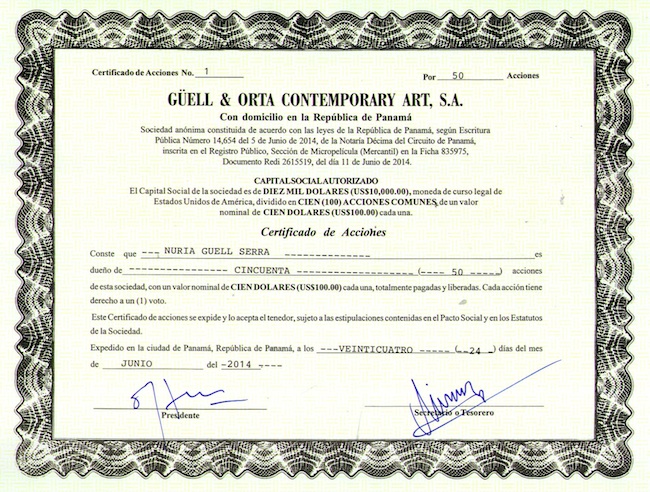
Núria Güell, in collaboration with Levi Orta. Arte Politico Degenerado, 2014 (detail: Núria Güells stock certificate).
Though their starting points and ambitions differ, Goldin+Senneby, Keller, and Güell illustrate how post-democratic power structures can be put to work in art. With their ability to appropriate and twist strategies of withdrawal, evasion, and legal ambiguity, the artists are rummaging through the practices of the corporate elite and transforming them into powerful tools for the politically abandoned.
Mikkel Rosengaard is a Danish writer based in New York City. He has published fiction and art journalism with various publishers, including tranzit.org and the New Museum’s Six Degrees blog.



